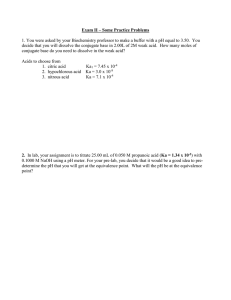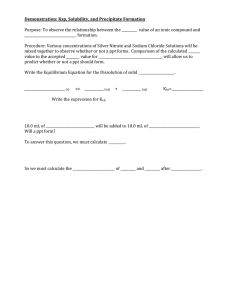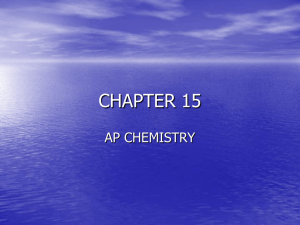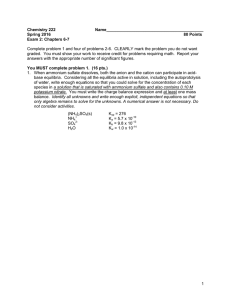. Which one of the following mixtures is suitable for making buffers
advertisement
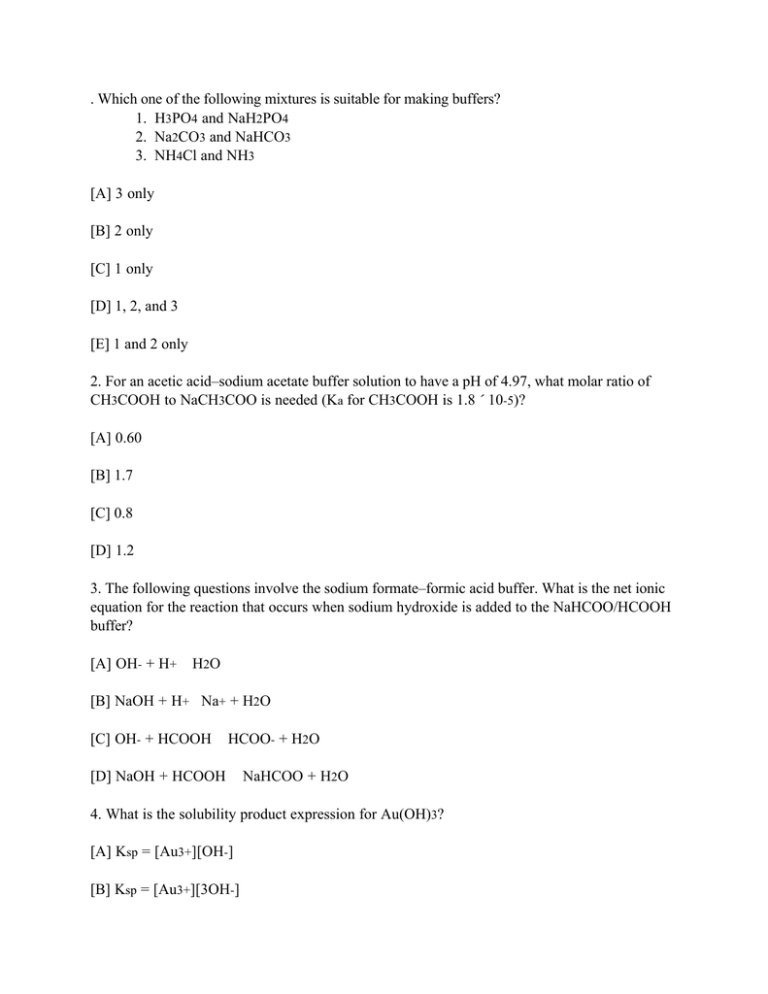
. Which one of the following mixtures is suitable for making buffers? 1. H3PO4 and NaH2PO4 2. Na2CO3 and NaHCO3 3. NH4Cl and NH3 [A] 3 only [B] 2 only [C] 1 only [D] 1, 2, and 3 [E] 1 and 2 only 2. For an acetic acid–sodium acetate buffer solution to have a pH of 4.97, what molar ratio of CH3COOH to NaCH3COO is needed (Ka for CH3COOH is 1.8 ´ 10-5)? [A] 0.60 [B] 1.7 [C] 0.8 [D] 1.2 3. The following questions involve the sodium formate–formic acid buffer. What is the net ionic equation for the reaction that occurs when sodium hydroxide is added to the NaHCOO/HCOOH buffer? [A] OH- + H+ H2 O [B] NaOH + H+ Na+ + H2O [C] OH- + HCOOH HCOO- + H2O [D] NaOH + HCOOH NaHCOO + H2O 4. What is the solubility product expression for Au(OH)3? [A] Ksp = [Au3+][OH-] [B] Ksp = [Au3+][3OH-] [C] Ksp = [Au3+][3OH-]3 [D] Ksp = [Au3+][OH-]3 5. The following data are to be used for the questions below. CaCo3 PbI2 AgBr Fe(OH)2 Co(OH)2 Ksp _________ 4.8 ´ 10-9 1.1 ´ 10-9 5 ´ 10-13 8 ´ 10-16 2.5 ´ 10-16 Which salt is the least soluble (mol/L) in water? [A] AgBr [B] PbI2 [C] CaCO3 [D] Co(OH)2 6. A saturated solution of PbBr2 is prepared by dissolving the solid salt in water. The concentration of Pb2+ in solution is found to be 0.0115 M. The Ksp for PbBr2 is [A] 1.2 ´ 10-5. [B] 6.1 ´ 10-6. [C] 2.6 ´ 10-4. [D] 4.9 ´ 10-5. 7. The solubility of PbSO4 is 0.041 g/L. Its molar mass is 303 g/mol. Its Ksp is [A] 8.8 ´ 10-12. [B] 1.7 ´ 10-8. [C] 1.7 ´ 10-3. [D] 1.3 ´ 10-4. 8. A 2 ´ 10-3 M solution of MnSO4 is gradually made more basic by adding NaOH. At what pH will manganese(II) hydroxide begin to precipitate? [Ksp of Mn(OH)2 = 2 ´ 10-13.] [A] 11 [B] 7 [C] 9 [D] 5 9. Ksp for Pb3(PO4)2 is 10-44. Two solutions are mixed, one containing Pb2+ and the other PO43-. If, at the instant of mixing, Pb2+ is 10-6 M and PO43- is 10-8 M, which one of the following statements is true? [A] No precipitate forms because Qsp < Ksp. [B] A precipitate forms because Qsp < Ksp. [C] A precipitate forms because Qsp > Ksp. [D] No precipitate forms because Qsp = Ksp. 10. The Ksp for AgI is 1 ´ 10-16. If you mix 500 mL of 1 ´ 10-8 M AgNO3 with 500 mL of 1 ´ 108 M NaI, then [A] sodium iodide will precipitate. [B] 1 ´ 10-8 moles of AgI will form. [C] AgI will precipitate. [D] no precipitation will occur. 11. To 1.0 L of water 2.0 ´ 10-6 mol of Pb(NO3)2, 6.0 ´ 10-6 mol of K2CrO4, and 1.0 mol of NaCl are added. What precipitate, if any, will form? (Ksp for PbCrO4 = 1.0 ´ 10-16; Ksp for PbCl2 = 2.0 ´ 10-5.) [A] No precipitate will form. [B] both PbCl2 and PbCrO4 [C] PbCrO4 [D] PbCl2 12. When 0.1 mol of solid silver nitrate is added to 1.0 L of clear, SATURATED solution of Ag2CrO4 (Ksp = 2.4 ´ 10-12), which of the following will result? [A] The concentration of Ag+ in solution will not change. [B] Some Ag2CrO4 will precipitate. [C] The AgNO3 will settle to the bottom without dissolving. [D] None of these will happen. 13. Which of the following precipitates could be solubilized by the addition of dilute nitric acid? 1. Ag2CO3 2. AgC2H3O2 3. AgI [A] 1 only [B] 2 only [C] 3 only [D] 1 and 2 only 14. The Ksp for Ag2CO3 is 8 ´ 10-12; what is the concentration of Ag+ in a Ag2CO3 solution that is 0.010 M in CO32-? [A] 3 ´ 10-5 M [B] 2 ´ 10-9 M [C] 8 ´ 10-9 M [D] 6 ´ 10-5 M 15. Pure water is saturated with slightly soluble calcium fluoride, CaF2. Which of the following statements is TRUE concerning [Ca2+] in this system? [A] [Ca2+] = 0.5[F-] [B] [Ca2+] = Ksp [C] [Ca2+] = Ksp/[2F-] [D] [Ca2+] = Ksp/[F-] 16. The [OH-] of a saturated solution of Cu(OH)2 is 8.0 ´ 10-7 M. What is the Ksp for Cu(OH)2? [A] 6.4 ´ 10-20 [B] 2.6 ´ 10-19 [C] 1.3 ´ 10-19 [D] 5.1 ´ 10-19 17. The molar solubility of Ni3(PO4)2 in a saturated solution can be increased by adding [A] NH4Cl. [B] (NH4)3PO4. [C] Na3PO4. [D] HNO3. 18. The following information should be considered for the questions below. The solubility of zinc hydroxide at 25°C is 3.7 ´ 10-4 g/L. MW = 99.41 The pH of a saturated zinc hydroxide solution is [A] 5.43. [B] 8.87. [C] 5.13. [D] 3.57. 19. The following data may be useful for the questions below. A saturated H2S solution is 0.10 M. The equilibrium constant for the reaction 2H2S(aq) + H2O(aq) 2H3O+(aq) + S2-(aq) is 1.1 ´ 10-20. An aqueous solution buffered at a pH of 3.00 is saturated with H2S. What is the concentration of S2- in this solution? [A] 1.1 ´ 10-15 M [B] 1.1 ´ 10-6 M [C] 1.1 ´ 10-13 M [D] 1.1 ´ 10-16 M 20. The following equilibrium Ag+(aq) + Fe2+(aq) Fe3+(aq) + Ag(s) was established by combining equal volumes of 0.1 M AgNO3(aq) and 0.1 M Fe(NO3)2(aq). Which of the following will shift the equilibrium to the right? 1. Adding 0.1 M AgNO3(aq). 2. Removing some Ag(s) by filtering the mixture. 3. Decreasing the Fe3+ concentration by another chemical reaction. [A] 1 and 2 only [B] 2 only [C] 1 and 3 only [D] 3 only 21. What is the minimum concentration of Mg2+ that is needed to begin the formation of a precipitate of Mg(OH)2 in a solution of pH 10.5? [Ksp Mg(OH)2 = 6 ´ 10-12.] [A] 4 ´ 10-4 M [B] 2 ´ 109 M [C] 2 ´ 10-5 M [D] 6 ´ 10-5 M 22. At 25°C the Ksp for MgCO3 is 4.0 ´ 10-5 and that for BaCO3 is 8.1 ´ 10-9. Assuming that both Mg2+ and Ba2+ ions have 1.0 ´ 10-3 M concentrations, what is the equilibrium concentration of carbonate ions that will precipitate the maximum concentration of Ba2+ without precipitating any Mg2+ at 25°C? [A] 4.2 ´ 10-3 M [B] 3.2 ´ 10-2 M [C] 4.0 ´ 10-2 M [D] 3.5 ´ 10-3 M 23. The rate of a chemical reaction [A] is approximately doubled for a 10°C rise in temperature. [B] between gases should in all cases be extremely rapid because the average kinetic energy of the molecules is great. [C] is constant at any given temperature regardless of other factors. [D] is independent of the amount of contact surface of a solid involved. 24. The oxidation of ammonia produces nitrogen and water via the reaction 4NH3 + 3O2 2N2 + 6H2O. If the rate of formation of N2 is 2.0 mol/(L • s), then the rate at which [A] H2O is being formed is 2.0 mol/(L • s). [B] O2 reacts is 1.5 mol/(L • s). [C] NH3 reacts is 4.0 mol/(L • s). [D] NH3 reacts is 0.50 mol/(L • s). 25. The equation and the rate law for the reaction between NO(g) and H2(g) are 2NO(g) + 2H2(g) N2(g) + 2H2O(g) Rate = k[NO]2[H2] The reaction order for hydrogen is [A] 0. [B] 3. [C] 2. [D] 1. 26. For a first order reaction, what are the possible units of the rate constant? [A] mol/L • s [B] 1/s [C] mol/L [D] 1/L • s 27. If the rate law for a reaction is R = k[ClO3-][I-][H+]2 what are the units of k when time is in seconds and the concentration is in moles per liter? [A] [B] [C] [D] 28. The rate law for the chemical reaction 5Br- + BrO3- + 6H+ 3Br2 + 3H2O has been determined experimentally to be rate= k[Br-][BrO3-][H+]2 The overall reaction order is [A] 2. [B] 1. [C] 3. [D] 5. [E] 4. 29. For the reaction (CH3)3CCl + OH- (CH3)3COH + Clit is found experimentally that doubling the concentration of (CH3)3CCl causes the reaction rate to be increased twofold but doubling the concentration of OH- has no effect on the rate. The rate equation is [A] R = k[(CH3)3CCl]. [B] R = k . [C] R = k[(CH3)3CCl][OH-]. [D] R = k[(CH3)3CCl]2[OH-]. 30. Nitrosyl chloride is produced from the reaction of nitrogen(II) oxide and chlorine. 2NO(g) + Cl2(g) 2NOCl(g) The following initial rates at a given temperature were obtained for the concentrations listed below: The experimental rate law is [A] rate = k[NO]. [B] rate = k[NO][Cl2]1/2. [C] rate = k[NO]2[Cl2]. [D] rate = k[NO]1/2[Cl2]. 31. In aqueous solution, iodine reacts with acetone as represented by the following stoichiometric equation: I2 + CH3COCH3 CH3COCH2I + H+ + IThe experimental rate law is Rate = k[H+][CH3COCH3] According to the information above, an increase in the hydrogen ion concentration has what effect on the reaction? [A] It decreases the value of the equilibrium constant. [B] It does not affect the rate of the reaction. [C] It decreases the rate of the reaction. [D] It increases the rate of the reaction. 32. A chemical reaction that is first order in x is observed to have a rate constant of 1.2 ´ 10-2/s. If the initial concentration of x is 1.0 M, what is the concentration of x after 200 s? [A] 0.071 M [B] 0.040 M [C] 0.050 M [D] 0.091 M 33. A first-order chemical reaction is observed to have a rate constant of 35/min. What is the corresponding half-life for the reaction? [A] 20 min [B] 18 min [C] 0.83 s [D] 1.2 s 34. The gas-phase decomposition of N2O5 is a first-order process with a rate constant of 1.50 ? 10-3/s at 55°C. The decomposition reaction is N2O5(g) 2NO2(g) + O2(g) Ten (10.0) g of N2O5 are placed in vessel 1 and 5.0 g of N2O5 in vessel 2. The vessels are at the same temperature and pressure. How much time is required for half of the N2O5 to decompose in each vessel? [A] Vessel 1 requires the same amount of time as vessel 2. [B] Vessel 2 requires twice as much time as vessel 1. [C] Vessel 1 requires twice as much time as vessel 2. [D] Vessel 1 requires three times as much time as vessel 2. 35. A reaction that is second order in one reactant has a rate constant of 1.0 ´ 10-2 L mol-1 s-1. If the initial concentration of the reactant is 0.100 M, how long will it take for the concentration to become 0.0500 M? [A] 10,000 s [B] 100 s [C] 1000 s [D] 500 s 36. In a first-order reaction the half-life is 116 minutes. The rate constant, k, in s-1 is [A] 1.0 ´ 10-4. [B] 0.060. [C] 6.0. [D] 3.6. 37. In a chemical reaction at constant temperature, the addition of a catalyst [A] provides an alternate reaction pathway with a different activation energy. [B] decreases the energy released in the chemical reaction. [C] increases the fraction of molecules with more than a given kinetic energy. [D] affects the equilibrium constant. 38. A reaction was observed to have a half life of 9.8 days at 1M concentration and was observed to have a half life of 12.3 days at 1.5 M. What is the order of this reaction? [A] 0 order [B] 1st order [C] 3rd order [D] 2nd order 39. 25 mg of PbCl2 solid and 25 mg of AgCl solid were allowed to come to equilibrium in 1 L of solution. What is the concentration of Pb2+ in solution. AgCl MW = 143.31 Ksp =1.8 x 10-10 PbCl2 MW = 278.1 Ksp =1.7 x 10-5 [A] 9.0 x 10-5 [B] 6.4 x 10-5 [C] 1.7 x 10-4 [D] 1.6 x 10-2 40. 25 ml of 0.1 M NaOH was added to 30 ml of an acetate buffer buffer at pH 4.80. The new pH was found to be 4.94 what is the molarity of the original buffer? pKa = 4.80 [A] 3.5. [B] 10.5. [C] 5.5. [D] 7.0. Reference: [17.70] [1] [D] Reference: [17.76a] [2] [A] Reference: [17.74a] [3] [C] Reference: [18.1a] [4] [D] Reference: [18.12a] [5] [A] Reference: [18.23a] [6] [B] Reference: [18.26a] [7] [B] Reference: [18.27a] [8] [A] Reference: [18.37a] [9] [C] Reference: [18.40a] [10] [D] Reference: [18.46a] [11] [C] Reference: [18.47a] [12] [B] Reference: [18.52b] [13] [D] Reference: [18.48a] [14] [A] Reference: [18.45b] [15] [A] Reference: [18.58a] [16] [B] Reference: [18.60a] [17] [D] Reference: [18.70a] [18] [B] Reference: [18.75a] [19] [D] Reference: [18.81a] [20] [C] Reference: [18.35a] [21] [D] Reference: [18.43a] [22] [C] Reference: [14.2a] [23] [A] Reference: [14.6a] [24] [C] Reference: [14.10a] [25] [D] Reference: [14.12a] [26] [B] Reference: [14.13a] [27] [D] Reference: [14.28a] [28] [E] Reference: [14.14a] [29] [A] Reference: [14.15a] [30] [C] Reference: [14.30a] [31] [D] Reference: [14.35a] [32] [D] Reference: [14.36a] [33] [D] Reference: [14.42a] [34] [A] Reference: [14.46a] [35] [C] Reference: [14.48a] [36] [A] Reference: [14.60a] [37] [A] Reference: [14.43a] [38] [A] Reference: [18.52a] [39] [A] Reference: [17.68a] [40] [B]

